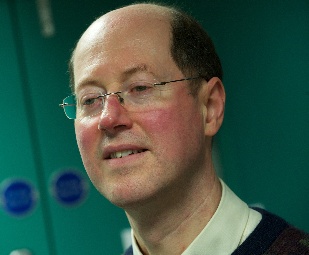
Professor Martin Dawson of the University of Strathclyde leads LED research
Tiny LEDs are being developed by academics to deliver Wi-Fi-like internet communications
As well as lighting buildings and outdoor spaces, LEDs are being used to transmit internet communications by academics at the University of Strathclyde.
Researchers say that by creating tiny LEDs which can flicker on and off thousands of times a second, and altering the length of these flickers, it is possible to send digital information to PCs and other electronic devices.
Described as the digital equivalent of Morse code, Li-Fi would make the visible part of the electromagnetic spectrum available for internet communications.
Professor Martin Dawson of the University of Strathclyde, who is leading the research, said the university is developing smaller, micron-sized LEDs which can flicker on and off 1,000 times faster than larger LEDs and therefore transmit data more quickly. For example, 1,000 micron-sized LEDs can fit into the space occupied by a single 1mm2 LED, with each LED acting as a communication channel. The result is the ability to communicate a million times more data. With each micron-sized LED acting as a tiny pixel, a large LED array display that is lighting an office boardroom can at the same time display information and provide internet communications.
Professor Dawson said: “Imagine an LED array beside a motorway helping to light the road, displaying the latest traffic updates and transmitting internet information wirelessly to passengers’ laptops, netbooks and smartphones. This is the kind of extraordinary, energy-saving parallelism that we believe our pioneering technology could deliver.”
In January, Lighting reported on Bytelight’s location-based technology which uses lighting to give building owners the ability to send and collate information to occupants at precise locations. The company uses lights as positioning beacons that can transmit signals that can be picked up by camera-equipped mobile devices.
The university is working with a consortium of UK academic institutions on the LED research project, including the universities of Oxford, Cambridge, Edinburgh and St Andrews. With the aim of bringing academia and industry together to discuss solid-state lighting/electronics and its implications for custom-controlled lighting systems, the University of Strathclyde is also setting up a Intelligent Lighting Centre.
The LED project is funded by the Engineering and Physical Sciences Research Council. To hear more about the project, access the audio slide show Li-Fi Multi-tasking micro-lights could spark a communications revolution.





